Plentiful pheasants and great dog work.
By Nick Sisley
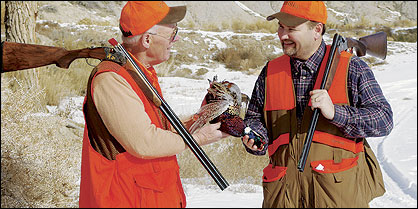 The author and Brad Howard talk ringnecks and shotguns. |
The dogs were already having a grand time. Frolicking and bounding every which way, Belle, Abby, Sid and Dixie were glad to be out of their confining boxes and stretching their legs across the vast but very cold Castle Valley, Utah, desert 180 miles south of Salt Lake City.
We hunters, six of us, were spread out across a cornfield that had obviously been none too prosperous for corn. But Dixie soon made it obvious that pheasants had a liking for that field. She was stacked up staunch less than 100 yards from our vehicles. Sid and Abby backed in a most mannerly fashion. Belle was 80 yards to my right, searching diligently, and tail switching back and forth excitedly.
Rick Van Etten and Brad Howard walked in, but by then I noticed to my right that Belle was locked on another bird. The rooster the trio of dogs had sat tight, a big mistake on his part, as Brad cut short his cackle-upon-rising with a shot from his 28-gauge over/under. Brad works for Beretta, so you can bet he wasn't carrying a Krieghoff.
I hurried over to Belle while Dixie, Abby and Sid were vying for the first retrieve of the day. Walking in all by myself, it could have been embarrassing, but I made short work of that rooster. I reloaded while Belle raced to the fall area. She brought the bird back to one of our two guides, Jeremy Lake. I looked back at the close proximity of the trucks, and thought to myself, "I'll bet this is going to be a pretty good day."
The pheasants probably were not thinking so. As shabby as the cornfield looked, the pheasants certainly loved it. So did the dogs, and they were a snappy quartet--three German shorthairs and a vizsla. By the end of the day Rick had already put out the word that he'd like to take the vizsla, Dixie, back to his home base in Iowa.
The timing was early December 2004, and although the short, regular season on ringnecks was over in Utah, Castle Valley has over 16,000 acres--a lot of it set aside as game preserve. Consequently, this working cattle ranch enjoys something like a seven-month bird season, but in reality the season doesn't last nearly that long.
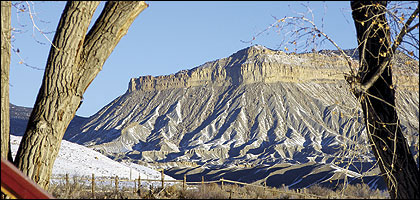 No wonder they call it Castle Valley. All around the valley, buttes like this, resembling castles, look down from the rim high above. |
Jeremy Lake raises thousands of pheasants, right from the egg stage, every year. Instead of planting "X" number of birds just before the hunt of each individual party, Lake puts out literally thousands of pheasants at a time--early on. Obviously, Castle Valley's game-preserve status allows the taking of hens, too. I've never been all that big on preserve pheasant shoots, but after hunting three days at Castle Valley I have to say that I've never seen better, more challenging preserve pheasant gunning.
The second day, while the rest of our party concentrated on hunting coyotes, Jason Nash of Federal Cartridge and I were the only ones hunting the pheasants. And to further emphasize the challenge of these Castle Valley roosters, Jason and I walked one heck of a long way between flushes. Which is as it should be; it was a hunt, as opposed to a shoot.
Ranch manager Jim Fauver had seen a black ringneck (Castle Valley raises quite a number of black-phase ringnecks and hens every year) with particularly long tail feathers. He had told us the area this bird liked to lounge around in, plus Jim had estimated the long tail to stretch maybe 25 inches. We hunted up a winding draw toward that area, Jason and I with the Beretta over/unders, Jeremy and his sidekick Casey Edgehouse handling the dogs. This time we still had Sid, Belle and Dixie, but Abby had been given a reprieve for the day, replaced by Casey's Weimaraner/vizsla cross, Rudy.
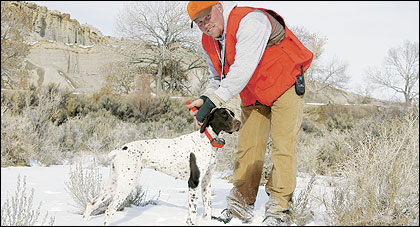 Jeremy Lake gets German shorthair Belle ready for the hunt. |
We did not find the long-tail where Jim had told us to expect him. Exiting the winding draw, we aimed the dogs at a hay field. Like the cornfield of the previous day, it was pretty sparse. We saw birds running ahead of us, but the dogs managed to nail a couple of tight sitters. Jason was shooting a 20-gauge Beretta Silver Pigeon III. He had it loaded with some new, very fast Federal 20-gauge 23?4-inch loads--one ounce of No. 5s at a whopping 1,350 feet per second (fps).
That's really fast for a 20-gauge load. This same load is also available in shot sizes 4, 6 and 71?2. Also new is a 20-gauge Federal 3-incher at 1,300-fps, 11?4 ounce of either No. 4s or No. 6s. Further yet are new 23?4-inch 12-gauge loads ideal for pheasants--11?8, 11?4 and 13?8 ounces, all at 1,500-fps.
I was shooting a new Beretta over/under, the Silver Pigeon V. It has beautiful game scene and scroll engraving, the birds in gold, plus a case-colored receiver. This one is the top of the Silver Pigeon line, but new for 2005, this one is available in 28 gauge built on a smaller 28-gauge frame. Previous Silver Pigeon 28 gauges have been built on a 20-gauge frame.
The one I carried in Utah was a 28 on the new, smaller frame. The 28-gauge pheasant loads ordered in from Federal had not arrived, but we did have some Federal 3?4-ounce target loads--size 81?2, hardly well thought of as a pheasant load, but we did just fine with them. Of course, we held off on the longer shots.
Jason and I enjoyed an afternoon of classic pheasant shooting. At daybreak that morning the thermometer was pegged at 0 degrees, but by afternoon the mercury column had climbed to about 30. Typical of the Utah desert, the sun was out in glorious form, never obliterated by one cloud.
The day before, when we started our hunt with six shooters and four dogs, I was feeling very leery. Six hunters in a line is not my figurative cup of tea, no matter the upland bird being hunted. In reality, however, our line worked just great. We were able to spread out plenty far apart due to the vast expanse of the Castle Valley shooting area.
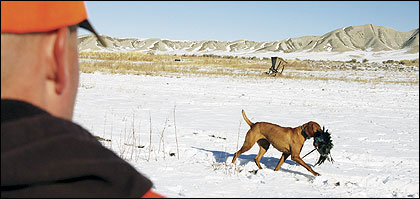 Dixie retriev es a pheasant. |
Four dogs down at once doesn't always work out, either, but the quartet we had scouring the country in front of us every day was exceptional. Each was very, very steady. If they ranged too far ahead of our line a very gentle "Back!" from handlers Jeremy or Casey would immediately return the dog or dogs to closer range.
Further, each and every dog was rock solid once on point, and they all backed immediately--with no encouragement from their handlers. Perhaps even more important, all the dogs we hunted over proved to be excellent retrievers. Despite occasionally knocking birds down in some thick cover, we never lost a pheasant.
Let's go back to that second day with Jason and me in the hay field. Once we had that patch covered we turned to the west, working the dogs through some good-looking sagebrush. Next we turned down one side of the upper end of the winding draw, the one where we had already hunted the lower end. Dixie went on point, but on the other side of the draw.
It would have been a steep climb down, then up, which I was ready to do, but Jeremy suggested I hold my position while Casey crossed the steep draw. He climbed out the other side, and then made a bit of a circle in front of the dog in an effort to flush the bird back over the draw and thus more in my direction.
His effort was wonderfully accomplished, which I rewarded by making a relatively easy crossing shot on a rooster--maybe typical of a High Three shot on a skeet field. But when my shot went off up came another bird, this time a black-phase hen. That one wasn't nearly as easy a shot, but the little 28 was very fast into action, and I connected.
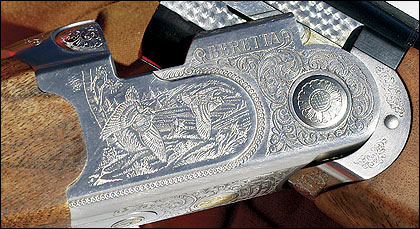 The 20-gauge Silver Pigeon II. Note the deep-relief game-scene engraving. |
It wasn't a double with both birds in the air at the same time, but it was close enough for me, as I immediately exclaimed, "Double. A double!" It was the only one I made at Castle Valley in three days, and the only chance I had at a double--typical of a pheasant hunt, where single-bird rises are the norm.
Within the next 20 minutes we had worked back into the area where Jim Fauver had seen the long-tailed black-phase rooster. I saw that one on the ground, or at least I saw a black cock with a heck of a long tail. But he was running and would not flush. A hen did, so I swung the Beretta on it. Again the light 3?4-ounce Federal 81?2s toppled the bird end over end, dead in midair.
After Sid brought that one back I hurried after the long-tailed black runner. Jeremy and I kept walking in semi circles, hoping to flush that one. But he outsmarted us, going out so far behind I didn't want to chance the light 81?2 28-gauge load. But we watched him down and soon were in pursuit again. We flushed this one again, a pretty wild, out-of-range flush, but we watched carefully where he lit, then hurried again in that direction.
The area where that rooster landed was replete with high sage and scrub cedar, so it was hard to see the dogs. This time the rooster sat tighter, but the flush was still well off to my left, not exactly where I expected it. At the shot the big black-phase came down, but both Jeremy and I knew this one was far from stone dead.
It didn't take Belle long to ferret that cripple out of the thick vegetation, however. That bird lost a tail feather or two in the battle with Belle, but Jeremy still measured what was left at 22 inches, long for any ringneck rooster, but I was particularly pleased to have bagged an unusual black-phase cock bird with such trophy-length tail feathers.
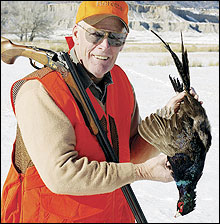 The author with a black-phase Castle Valley rooster, and the new Beretta Silver Pigeon V--in 28 gauge--built on the new, smaller 28-gauge frame. |
Shortly we were back at the vehicle, and Jeremy suggested we try "the corral." I didn't have a clue what that meant. It was a short drive away, and when we stopped the truck I had an inkling about what was about to ensue. I could see several birds trying to scurry out of sight as we got out of the truck.
Jeremy took Jason on a wide, curving path around the corral. Casey took me to a position on the same side of the corral as Jason, but 100 yards to his left. Casey told me to wait there, and then he went completely around the corral. Shortly he was flushing birds toward us.
I've shot driven pheasants in the Czech Republic, a very formal affair. The ensuing minutes in Utah didn't have that driven-shoot formality, but they did have the excitement. Soon Casey had hens and ringnecks galore flying overhead. I'd kill one bird, reload, only to have three fly unmolested overhead. I longed for two guns and a secretario, common in Spain on red-legged partridge shoots.
When the corral shoot was over Jason and I knew it was a perfect time to call the end to that day. At the truck Jeremy and Casey counted up the birds. We had shot 31 pheasants. Not a one had been planted that day. Our hunt lasted a full four hours, trudging in mostly six inches of snow and over quite uneven terrain. Our legs knew they had been somewhere. In all my 67 years I can't recall a better, more meaningful or more productive pheasant hunt.
Despite three days of banner success in the Utah desert with pheasants, then and now I can't quit thinking about the dogs and the dog work. Even when only Jason and I hunted, we had four dogs down in front. Continually, they just kept doing everything right. If there was one mistake on their part in three days of shooting, I never saw it. Though I've had my own so-called European breeds in years past, I've long been mostly a so-called "pointer and setter man," but all the dogs I saw at Castle Valley really impressed me, giving me the impetus to come home and try to bring my own dogs up to their standards.






